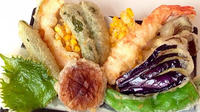Learn to Cook Traditional Japanese Food in Kamakura
Kamakura, Japan
Trip Type: Cooking Classes
Duration: 2 hours 30 minutes
”Washoku”, traditional Japanese cuisine, has been added to UNESCO insensible cultural heritage list on 2013.
You will visit a local house to learn and enjoy cooking either traditional Japanese meal or Shojin cuisine (Japanese vegetarian meal) with a professional Japanese cook.
You will visit a local house to learn and enjoy cooking either traditional Japanese meal or Shojin cuisine (Japanese vegetarian meal) with a professional Japanese cook.
More About This Activity All Cooking Classes →
”Washoku”, traditional Japanese cuisine, has been added to UNESCO insensible cultural heritage list on 2013.
You will visit a local house to learn and enjoy cooking either traditional Japanese meal or Shojin cuisine (Japanese vegetarian meal) with a professional Japanese cook.
Four features of Authentic Japanese cuisine "Washoku":
1. Respect of the each various and fresh foods characteristic is considered.
2. Healthy eating habits, excellent in nutritional balance.
3. Expression of a change of season and natural beauty.
4. Close relation by annual events, all year around.
Regular meal option:
If you are the first group who made the reservation of the requested date, you would have a right to choose which one to cook for the main dish of the day.
Here are a few example of main dishes that you can choose from:
-Oyako-don (chicken and egg)
-Shouga-yaki (ginger pork)
-Ton-jiru (pork miso soup)
-Saba no Miso-ni (boiled mackerel with miso flavor)
-Tempura (vegetables)
-Sukiyaki (beef)
-Zou-sui (rice in a soup)
-Maki-zushi (sushi roll)
-Nori-maki (sushi hand roll)
Shojin cuisine (Vegetarian):
You have 2 options for the main dish:
1. Tofu steak with Mushroom sauce"Tofu-steak Kinoko sauce"
2. Japanese Cooking Class"Kencho-jiru"Japanese tofu and Vegetable-chowder
What is "Shojin cuisine"
Shojin cuisine (Buddhist devotional cooking) is said to have originated from the essay, Tenzo Kyokun (Instructions for the Cook), written by Dogen Zenji, founder of Eiheiji Temple and the Soto school of Zen Buddhism.
The essay is full of teachings, such as the need to cook in a spirit of gratitude for the food. With these teachings as their foundation, contemporary Zen priests still prepare and eat shojin ryori as a kind of disciplinary practice.
The word “shojin” does not refer only to single-minded devotion to ascetic practices, but considers the preparation and eating of a meal as a discipline that refines the spirit, just like Zen meditation.
Shojin cuisine equates to the vegetarianism with which we contemporary folk are familiar. According to the five precepts of Buddhism, it is forbidden for a monk to take a life, and Mahayana Buddhism also prohibits the eating of meat.
Shojin cuisine thus emerged as a way of cooking that worked resourcefully with vegetables, beans, and grains so that food could be offered to monks.
You will visit a local house to learn and enjoy cooking either traditional Japanese meal or Shojin cuisine (Japanese vegetarian meal) with a professional Japanese cook.
Four features of Authentic Japanese cuisine "Washoku":
1. Respect of the each various and fresh foods characteristic is considered.
2. Healthy eating habits, excellent in nutritional balance.
3. Expression of a change of season and natural beauty.
4. Close relation by annual events, all year around.
Regular meal option:
If you are the first group who made the reservation of the requested date, you would have a right to choose which one to cook for the main dish of the day.
Here are a few example of main dishes that you can choose from:
-Oyako-don (chicken and egg)
-Shouga-yaki (ginger pork)
-Ton-jiru (pork miso soup)
-Saba no Miso-ni (boiled mackerel with miso flavor)
-Tempura (vegetables)
-Sukiyaki (beef)
-Zou-sui (rice in a soup)
-Maki-zushi (sushi roll)
-Nori-maki (sushi hand roll)
Shojin cuisine (Vegetarian):
You have 2 options for the main dish:
1. Tofu steak with Mushroom sauce"Tofu-steak Kinoko sauce"
2. Japanese Cooking Class"Kencho-jiru"Japanese tofu and Vegetable-chowder
What is "Shojin cuisine"
Shojin cuisine (Buddhist devotional cooking) is said to have originated from the essay, Tenzo Kyokun (Instructions for the Cook), written by Dogen Zenji, founder of Eiheiji Temple and the Soto school of Zen Buddhism.
The essay is full of teachings, such as the need to cook in a spirit of gratitude for the food. With these teachings as their foundation, contemporary Zen priests still prepare and eat shojin ryori as a kind of disciplinary practice.
The word “shojin” does not refer only to single-minded devotion to ascetic practices, but considers the preparation and eating of a meal as a discipline that refines the spirit, just like Zen meditation.
Shojin cuisine equates to the vegetarianism with which we contemporary folk are familiar. According to the five precepts of Buddhism, it is forbidden for a monk to take a life, and Mahayana Buddhism also prohibits the eating of meat.
Shojin cuisine thus emerged as a way of cooking that worked resourcefully with vegetables, beans, and grains so that food could be offered to monks.
« Go Back

